I am not a baker. I am a chef, and therefore I got my own ideas how food can work.
I wanted a cinnamon bagel fine crumb with a nice tough crust. No egg, butter, milk or oil.
Right I did do a little research about lye, baking soda, potato water, blanching, rolling and oven temperature
Make potato water:
- 180 gr nice golden potato can be any like annabel or agria
- 1 ltr water
cook the potato, no salt. cool down and blend
make a starter by mixing:
- 3 C bakers flour
- 1 C rye flour
- 1 t active dried yeast
- 3 1/2 C room temprature potato water (will be creamy)
place everything in a kitchen mixer use a hook, I use a kitchen aid, wait until everything is mixed and put on full until the dough starts to crawl up the hook. This can take 10 minutes.
Covered the bowl with plastic and left it to double in volume on the bench
Back under the machine with the hook and add:
- 3 C bakers flour
- 2 t malt flour
- 1/2 t dried active yeast
wait until everything is mixed and put on Medium low until the dough starts to crawl up the hook. This can take 10 minutes.
add:
- 1 1/2 t iodised fine salt
- 1 C currants (dry)
- 2 t mixed spice (cinnamon, cardamom, anise, clove)
mix very well. easy to follow just look at the colour of the spice, don't worry about the currants.
I placed the dough in a large plastic container with lid and wrapped it up in a blanket. until again double in volume.
divide into portions of 100gr and round up

Bring a pan of water to the boil (apprx 5ltr) add 2 T malt flour mixed with a little cold water, and 1 T baking Soda
push your index finger through the middle and make an even hole in the middle (even better: roll into a ribbon and connect the ends with a little water, press to hold)
leave on baking paper covered tray for another 20 minutes under a cloth
blanch the bagels in the boiling water for 1 minute (1/2 minute each side, flip them over in the water)
pre heat the oven top and bottom heat 260°C no fan (500°F)

place back on the baking tray and let them cool, meanwhile they will rise a little

place the tray in the middle of the oven, lower the oven to 230-225°C (450°F) bake for 22 minutes

let them cool! let them cool! let them cool! time will give the crust it's toughness and the bread can settle.
very nice with some aged cheddar, or dried salami it's worth the wait
Have fun making them and bon appetite
